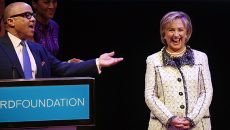Prospects for a resurgent tea party in 2014

CARRYING THE MESSAGE: Bernie Brunner, of Springfield, Pa., holds a flag during a tea party rally in 2013 in Philadelphia protesting extra IRS scrutiny of their groups.
By Christopher G. Adamo
Liberal Democrats and establishment Republicans have been foretelling of the death of the tea party ever since early 2009, shortly after the movement began.
In the immediate aftermath of Barack Obama‘s first inauguration, shell-shocked conservatives assessed the degree to which their interests had been abandoned by the Republican Party, and how clumsy and insipid the GOP had been in its opposition to the liberal agenda.
They recognized that this pattern showed no signs of improving until such time as they could exert their influence on the self-serving party insiders, or exact a political price from them if conservative interests continued to be ignored.
From the beginning, the tea party movement has been the bane of the D.C. business-as-usual crowd on both sides of the political aisle, while exhibiting a startling degree of resistance to the standard corrupting forces of the political power brokers.
Tea party gatherings and protests arose with seeming spontaneity in major cities across the nation and on the Washington Mall, as if thoroughly coordinated by some power that remained invisible to the entrenched members of the political class.
The crowds were enormous, easily dwarfing attempted liberal counter protests, though the latter were widely trumpeted and given glowing coverage by the “mainstream” media in a futile effort to create the impression that the nation really had made a deliberate turn to the left.
As the momentum of traditional America continued to coalesce, the political left increasingly felt the threat from it and reacted predictably to it. On the nightly news, participants of tea party gatherings were intentionally disparaged as “tea baggers,” a disdainful term alluding to perverse sexual activity. Other efforts to neutralize the movement included flagrant lies and distortions of the nature of protests, including accusations of racism and violence, though no such incident was ever reported at a tea party gathering.
On the day Congress passed the atrocity of Obamacare, then-Speaker of the House Nancy Pelosi, D-Calif., stalked directly through a large tea party group that had assembled to oppose the measure, wielding an enormous gavel and claiming after the fact that she had been threatened by the protesters. Other liberal Democrats in her company made similarly outlandish accusations of racial epithets ostensibly hurled against them.
To the chagrin of those Democrats and their fellow propagandists and media lapdogs, many of the tea partyers produced video recordings of the incident and were able to offer incontrovertible proof that no such harassment had occurred.
In a strong sense, the manner in which they, acting individually as free citizens, were able to completely debunk the onslaught of contrived liberal propaganda represented the essence of the movement and its indomitable strength.
Nevertheless, liberals continued to voice their assurances that the effort was dissipating. Yet the tone of their pronouncements, sounding increasingly panicked and desperate as the November 2010 mid-term elections approached, exposed the magnitude of their fears that the people on Main Street finally had been awakened, and were on the verge of imposing their retribution on those self-serving power brokers inside the Beltway. And ultimately the election results of 2010 were just that, especially in the House of Representatives where the Democrats suffered a net loss of 63 seats, decisively costing them the majority.
So of course the Democrats and their media minions shifted their focused to the Senate, where tea party fortunes had not been nearly so encouraging. Having fielded such candidates as Christine O’Donnell in the Delaware race, and displacing entrenched “moderates” in the process, the threat of a full blown tea party insurgency clearly represented a dire threat to the ruling class.
In response, many politicians and pundits, including some who claimed to be on the right, endeavored to undermine their efforts and blunt their momentum. Former Bush 43 adviser Karl Rove essentially campaigned against O’Donnell. Yet he was hardly alone.
Other prominent voices of the officially sanctioned “conservative” movement were eager to seize on O’Donnell’s loss, along with the failed Senate candidacies of Sharron Angle of Nevada and Carly Fiorina of California, as proof that the movement had only succeeded in forfeiting Senate seats that ostensibly could have been won by “moderates,” had the Republican Party gotten its handpicked candidates through the primary challenges.
And in a thoroughly disingenuous contortion, the 2012 loss of Mitt Romney (the quintessential “mainstream” Republican) to Barack Obama has been touted by the GOP inner circle as evidence of an irreversible national shift to the left. This defeat, we are told, cannot possibly signal disillusionment with Republican “centrism.” Rather, it could only have been proof that Romney was “too conservative” and that any successors who hope to fare better than he did must tack even further to the “middle.”
In keeping with this ploy, Republican leaders in the House and Senate have stepped up their efforts to marginalize the tea party, with House Speaker John Boehner purging key members of the House Budget and Financial Services Committees on account of their affiliation with the tea party.
Senate Minority Leader Mitch McConnell has likewise engaged in his own efforts to maintain the Washington status-quo, claiming to embody conservatism while remaining apparently oblivious, or perhaps indifferent, to the fact that the conservative cause has not fared well under his headship. Though he refuses to strenuously oppose any facet of the Obama agenda, he stridently declares that those genuinely on the right “give conservatism a bad name,” and he further contends that they are “ruining the Republican brand.”
If the career politicians have their way, the uprising of grassroots conservatives will be shamed into silence and eventually lose steam, at which point the “Ruling Class” can get back to its business as usual. However, with the fate of the country a much greater matter of concern to heartland America than the fate of the GOP, this scenario is unlikely.
The Senate Conservatives Fund, an organization that McConnell regards with particular contempt, is endorsing Matt Bevin, who is challenging McConnell in the Kentucky Republican primary.
Speaker Boehner may well suffer a similar fate. The Tea Party Leadership Fund has pledged $25,000 toward a primary challenge to Boehner. And while that sum may seem paltry in comparison to the massive campaign expenditures and cronyism that have thoroughly perverted and dominated D.C. politics, its effects potentially can be enormously magnified by their resonance with the people on Main Street.
Ultimately, while big money may wield an excessive influence on the political maneuverings of government, no amount of political treachery, media propaganda, or baseless assertions of “conventional wisdom” can overrule a concerned and informed citizenry that knows the country is hanging by a thread, and is committed to its restoration.
Christopher G. Adamo is a resident of southeastern Wyoming and has been involved in state and local politics for many years. He writes for several conservative websites, and has written for regional and national magazines. He is the chief editorial writer for The Proud Americans. His contact information and article archives can be found at www.chrisadamo.com, and he can be followed on Twitter @CGAdamo.
The post Prospects for a resurgent tea party in 2014 appeared first on Watchdog.org.







